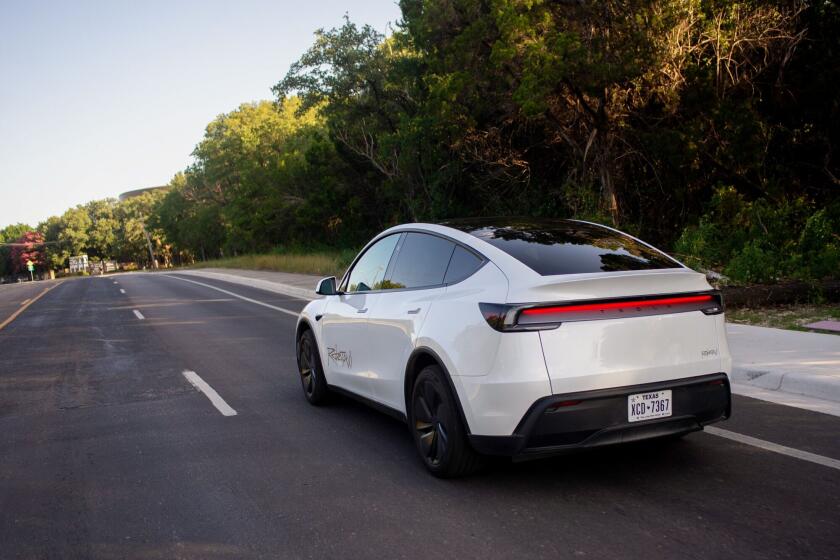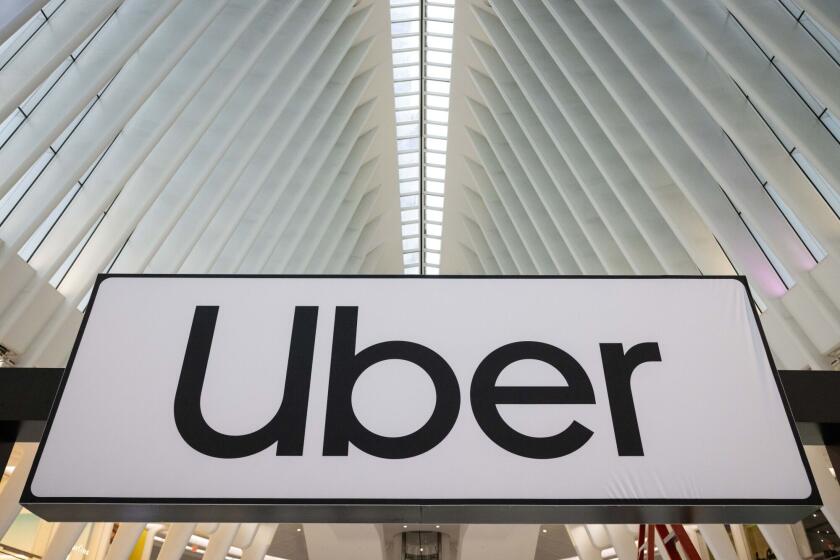Los(t) Angeles
- Share via
Ask Steve Nazarian, 39, proprietor of Crown Liquor & Deli, just how confusing the local streets are.
Nazarian’s store is at 130 N. Robertson Blvd. in Beverly Hills. As the boulevard flows north from adjacent Los Angeles, the numbers skip. A Beverly Hills parking lot stands where a Los Angeles address seemingly should be.
Nor does the strangeness end there.
Even if northbound motorists realizes they have crossed into Beverly Hills and a new numbering scheme, that knowledge will only serve for a few blocks. Then Los Angeles suddenly resumes. A few blocks farther, the numbers skip yet again as Robertson Boulevard leaps into West Hollywood.
Try explaining all this to the deliriously lost motorists who come into Nazarian’s store every day asking--no, demanding--to know the whereabouts of a missing address. How could a building vanish, they ask, only to be replaced by a parking lot?
Nazarian points to a hand-written sign explaining Robertson’s vagaries. Unfortunately for many steamed motorists, it is too little, too late.
So Nazarian, who after all has a business to run, sometimes falls back on the ultimate stonewalling tactic. He just shakes his head and plays dumb.
Welcome to the Southland and its hodgepodge of confusing streets. Often, streets run just a few blocks before disappearing, cut off by a freeway or other development, only to resurface several blocks later as if mysterious underground rivers.
Welcome also to the boggling phalanx of adjacent streets with nearly identical names.
In close proximity are Beverly Boulevard and Beverly Drive. Elsewhere, Mulholland Drive intersects Mulholland Highway, which is different, of course, from Mulholland Way, not to mention Mulholland Terrace, and Mulholland Place.
So which is which? Who can remember?
Similarly, Hollywood Hills boast streets called Ridge Oak and Holly Oak, Valley Oak and Alto Oak, Green Oak and Spring Oak and Park Oak and Wild Oak. There is an endless array of oaks, each looping into another oak, the combination seemingly designed to insure that any visitors will remain lost. Permanently.
And, God forbid someone should give out a Live Oak address. There is, of course, such a street in Hollywood. But then again, it may be somewhere else entirely depending if it is Live Oak Avenue, East Live Oak Avenue, North Live Oak Avenue, or West Live Oak Avenue. Or maybe it’s Live Oak Court, Live Oak Drive, East Live Oak Drive or West Live Oak Drive, Live Oak Lane, Live Oak Street or East Live Oak Street. Or perhaps it is Live Oak Ter. (Terrace) as opposed to Live Oak Tr. (Trail). (Tricky, that one, isn’t it?)
This, then, is the Southland reality: individuals driving erratically with heightened blood pressure and deteriorating mental health, businesses wasting time trying to deliver goods and pollutants needlessly spewed as motorists blindly search out confusing addresses.
Amazingly, no study has apparently been done on the costs of all this. Then again, the region’s movers and shakers insist that the emperor is wearing a full set of clothes. Con Howe, planning director for the city of Los Angeles, for example, says that L.A.’s streets work better than those of many other cities. He cites, as an example, Washington, which boasts identically named streets in different quadrants, with only an NW or SE to differentiate them. There, he says, hapless motorists may suddenly discover they are not only on the wrong street; they’re also miles from their destination.
Greg Hise, assistant professor of urban planning at USC, similarly opines that “each area tends to be fairly consistent. It’s only at the boundaries that things don’t work.”
Then again, the “Thomas Guide” to Los Angeles County deems it necessary to devote 187 pages to mapping out those “fairly consistent” areas, adding 1,620 new streets over the last three years for those of us who lack Hise’s more worldly perspective. So here’s a modest proposal.
Isn’t it time we realize that Los Angeles and Santa Monica, Beverly Hills and West Hollywood, Pasadena and Inglewood may once have been separate cities, but are now, de facto, integral parts of a larger whole? Isn’t it time we realize that visitors driving down an avenue from one city to another would benefit from consistent numbering on both sides of the divide?
What if we moved bravely into the future, renaming and numbering streets on a regional, not a local, basis? What if adjoining streets had clearly contrasting names?
Sure, a change will cost us in terms of new stationery, streets signs, etc. But we don’t insist that, to lower costs, the Southland retain outdated area codes. Why not similarly rid ourselves of our outdated street plans?
For over and above the costs of aggravation, higher delivery expenses and air pollution, we pay yet another cost for our self-imposed, Alice-in-Wonderland system; we too often lose our sense of being at home. Too often unsure of where any place is or how to get there, we have become, in fact, strangers in our own strange land.
What might it otherwise be like? Says Nazarian: “As soon as a UPS man or taxi driver comes into the store, I know whether he’s looking to buy something or looking for an address. I can read it from how he walks in, his body language.
“If they took care of this, then I could have more time and energy to run my business. Then, I could relax.”
More to Read
Sign up for Essential California
The most important California stories and recommendations in your inbox every morning.
You may occasionally receive promotional content from the Los Angeles Times.













